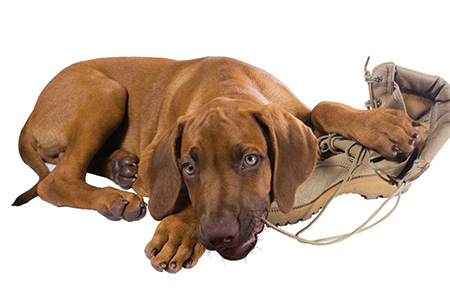Foreign Body Removal in Pets

Foreign body obstructions can be caused by anything not easily digestible, including string, clothing, sticks, children’s toys, bones, or trash. Obstructions can occur at any point in the gastrointestinal tract. Though some foreign bodies in the stomach can be located and removed via endoscopy, most obstructions will require abdominal surgery.
How do I know if my pet has a foreign body obstruction?
Signs will vary based on location, duration of the obstruction, and size and type of the object, but some common early signs include:
- Vomiting, especially multiple, frequent episodes (this can be food and/or just liquid)
- Loss of appetite
- Abdominal pain/tenderness
- Lethargy and inability/unwillingness to do normal routines
- Occasional hiding or vocalizing
Though these signs, together or alone, can indicate an obstruction, they can also indicate many other health concerns. The only way to be sure your pet is suffering from a gastrointestinal obstruction is to call your vet and have some diagnostics performed. A gastrointestinal obstruction is a veterinary emergency. If left untreated, it can cause sepsis (severe whole-body infection) and/or rupture of the GI tract. Both are potentially life-threatening complications.
What is a foreign body removal, and how is it performed?
Call your vet immediately if you suspect your pet has ingested something that she may not have passed. If, after performing a complete examination, your vet suspects your pet has a foreign body, an X-ray and possibly other imaging will be ordered to confirm the obstruction and pinpoint its location.
Foreign body removal is performed under general anesthesia. Because this carries risks, bloodwork to check a complete blood count and liver and kidney function will be taken to determine if your pet needs extra monitoring and treatments before, during, and after surgery.
In order to gain access to the foreign body, the surgery is performed by making an incision into the abdomen. Once your veterinarian has entered your pet’s abdomen, a full assessment of the abdominal organs will be performed. Once the presence and exact location(s) of the foreign material and the extent of the damage caused by the foreign body have been determined, careful and precise incisions are made into the stomach and/or intestines to remove the foreign material. The duration and invasiveness of the surgery will depend on the location and severity of the obstruction.
If your pet’s veterinarian is able to locate the obstruction immediately and the intestines at the point of obstruction are healthy, the surgery will be relatively quick. Occasionally, more extensive incisions or resections (removal of part of the intestines) will be necessary depending on the number and size of foreign bodies and the damage to the gastrointestinal tract. The incisions into the GI tract and the abdominal wall will be carefully closed with sutures to ensure proper healing of these areas.
Whenever possible, our veterinarians will choose the best balance of minimal invasiveness and thorough exploration to ensure your pet makes a full and quick recovery.
How safe is a foreign body removal, and what kind of recovery can I expect for my pet?
The risks associated with foreign body removal will vary depending on the extent of the damage caused by the obstruction, your pet’s overall health status, and the extent of the surgery needed to repair the damage. Though the surgery is lifesaving, foreign body removal is not minimally invasive and carries more risks than routine surgeries. There is a small but possible risk of sepsis from damaged intestinal tissue during or after the surgery. There is also a risk of the surgical incisions into the intestines or abdomen dehiscing (opening up) from complications such as failure of the suture material, damaged intestines being unable to hold the sutures, and too much post-op activity by your pet. Typically, however, obstructions caught early will have an excellent prognosis, and your pet will feel much better immediately after the surgery than before. Most pets recover very well with minimal pain or complications.
Since all surgeries and patients vary, your pet will need to be monitored at least overnight, until she is eating again, and possibly for several days after that. Your vet will determine if your pet needs IV fluids or additional supportive care during recovery, but most pets will be eating again within two to three days, and clinical signs of obstruction will steadily resolve.
You will need to limit your pet’s activity almost entirely during the initial two-week recovery period to allow the internal and external incisions to heal. You’ll get to give your furry friend a lot of extra love as she recovers. With careful postoperative care, your pet should make a full recovery within two to three weeks. It is essential to understand your pet will NOT learn from the experience. It will become vital for you to keep your pet safe by removing enticing foreign objects from her reach. It is not uncommon for a pet to ingest foreign bodies again after undergoing surgery to remove previous objects.
Call us immediately if you suspect your pet may have a foreign body obstruction. Our friendly and knowledgeable staff are happy to answer your questions.


